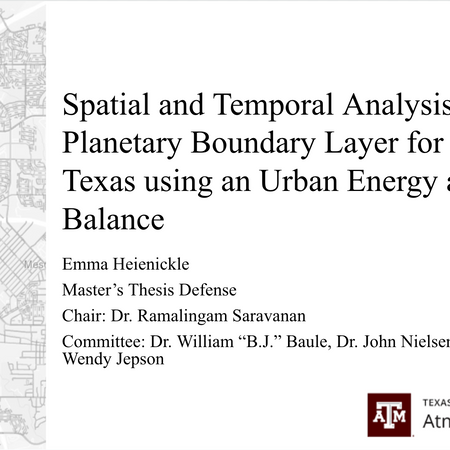
Spatial and Temporal Analysis of Mesquite, Texas
This is my thesis project for my masters degree in Atmospheric Sciences.
Abstract:
This thesis explores the energy and water balance of Mesquite, Texas to investigate the temporal and spatial heterogeneity land cover change imposes on the lower atmosphere. The model SUEWS, Surface Urban and Energy Water Scheme, was used to analyze past and current land cover maps for five study areas within Mesquite. The land cover images were created from the most recent LiDAR (Light Detection and Ranging) point cloud data – 2019 and ten years prior in 2009. The LiDAR data is at a one-meter spatial resolution and the meteorological data is at a one-hour temporal resolution. As cities continue to increase in population, create new infrastructure, and expand, there are greater land use and land cover changes (LULCC) occurring and influencing the atmosphere. Within the energy balance, net radiation, storage, latent, and sensible heat fluxes were studied. The water balance included precipitation, evaporation, runoff, and drainage outputs. A validation of the energy fluxes was completed for an observational site in northwest Dallas-Fort Worth; the SUEWS model output showed strong correlations to the observation values. In Mesquite, there was an overall increase in pavement and buildings and a decrease in grass and tree cover from 2009 to 2019. These LULCCs resulted in an increase in net radiation, storage heat flux, runoff, and drainage. Further, the latent heat flux and evaporation showed decreased model output values with the new land cover. An in-depth understanding of how enhanced urban development and LULCCs have influenced the local water and energy balance is necessary as cities house greater populations of people and aim to become more sustainable in the face of a changing climate.
Project Gallery






